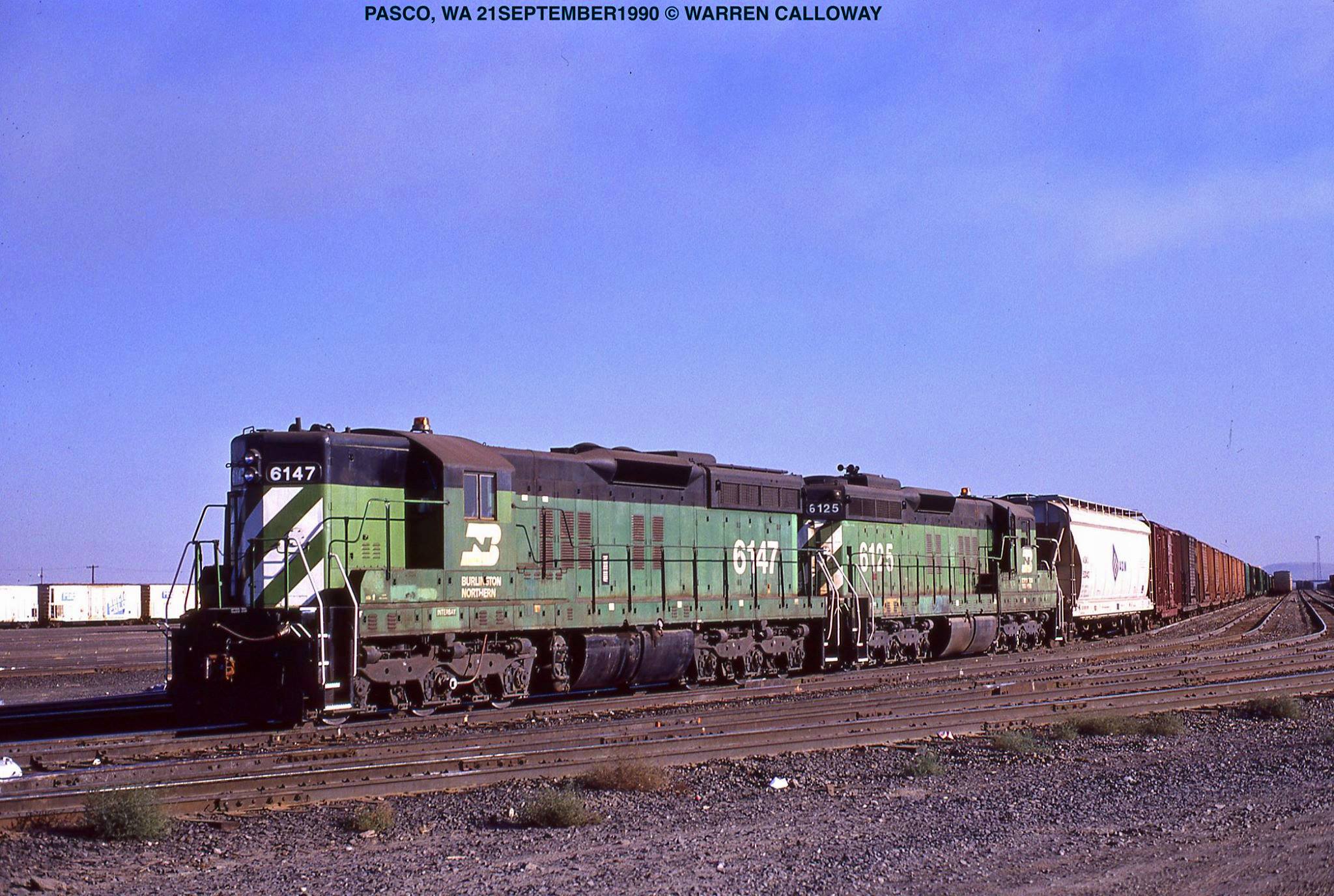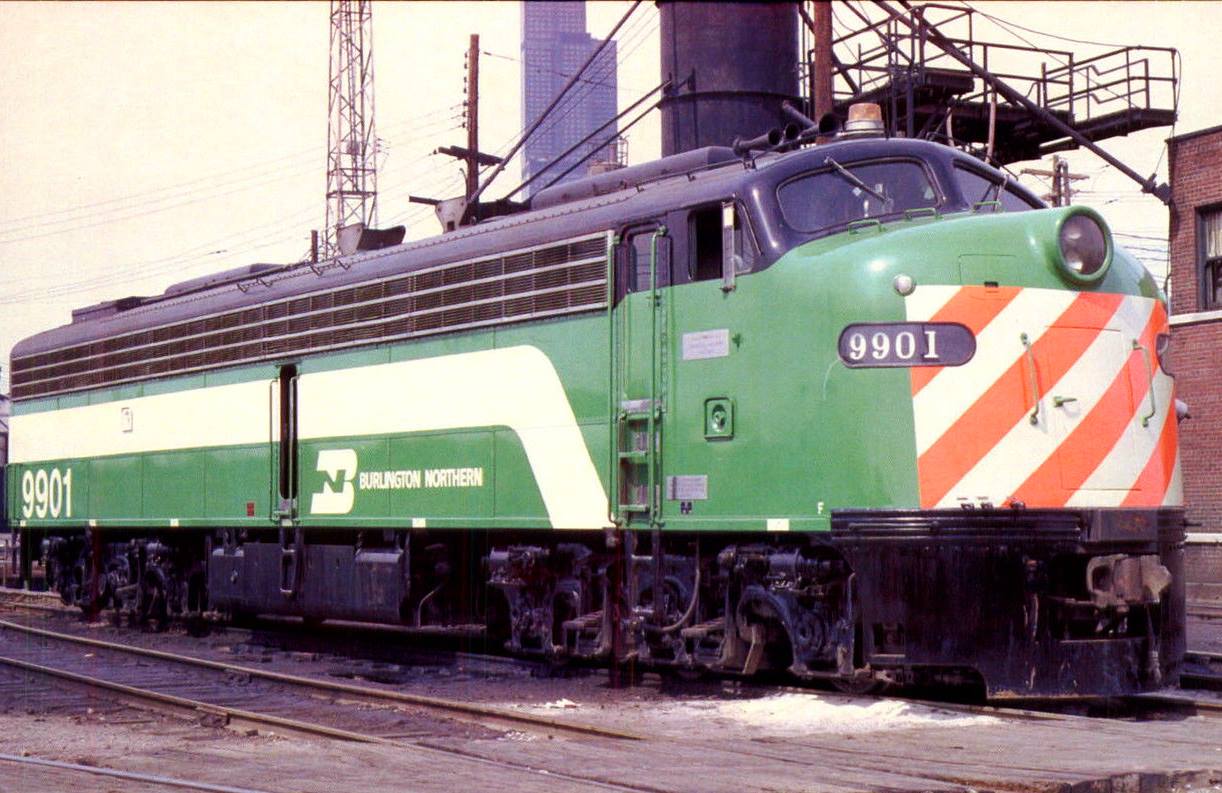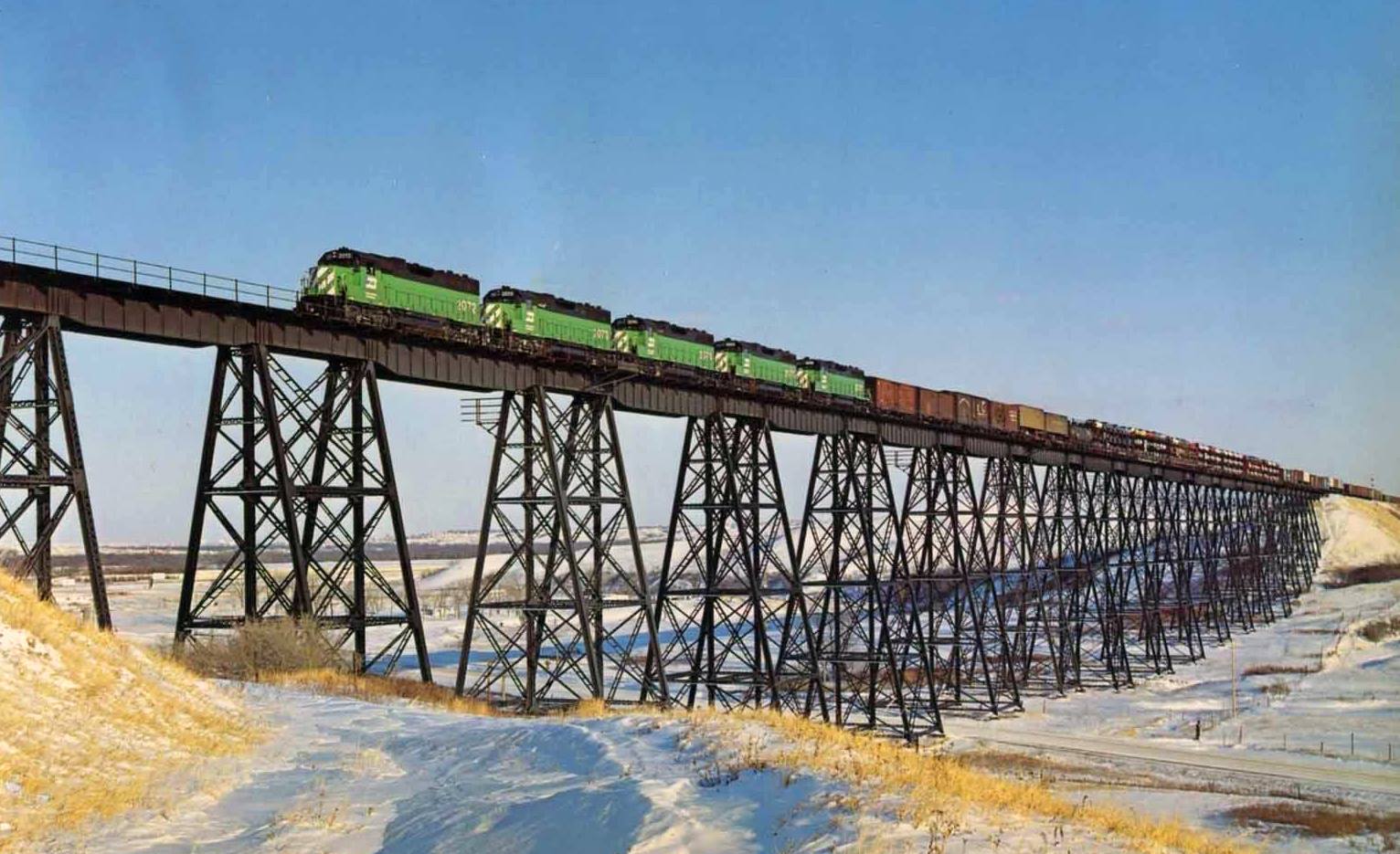Scrap Iron, Big Foot, And A Nice Day On A Branch Line
Last Revised: December 28, 2021
By Tom Schuppert
Seems like most guys in railroading acquire a nick name sooner than later. My conductor goes by the name of Scrap Iron. He didn’t get that name with the job though – he’s had that all his life.
We’ve known each other since we were kids living on the same block. His father started calling him Scrap, or Scrap Iron, back when he was in his early teens.
In the years before he could drive a car, his folks tried to satisfy his obsession for mechanized travel by getting him a used dirt bike one summer and a used snowmobile one winter.
His father gave him the nick name after proving he could quickly reduce nearly any vehicle to scrap iron through failed acrobatics.
The Scrap Iron name stuck and that’s what everyone called him – his parents, teachers, friends, and anyone who had, or has contact with him. In fact many people who know him have no idea his true name is Mark Cadillac.
Shortly after high school, Scrap took a job as a trainman with the Union Pacific. Not long after that I started with the Burlington Northern.
We didn’t see much of each other for several years. Then one day he called to tell me he started with a regional railroad. He told me about all the working advantages of a smaller railroad.
He said he wouldn’t miss the impersonal number-like relationship between management and employees on the Class 1s. Scrap also called to tell me that the railroad he worked for was in need of an engineer, and he told the HR person he’d give me a call.
The short version of this story is that I did indeed make the transition to the regional line on the other side of the state. In the years that followed, circumstances change, things happen, and people move on.
But Scrap and I always seem to end up on the same railroads together. Now we’re both working on the same short line. Convinced we’re too old to keep moving around, we decided to stay put and remain with this railroad. We’ll see.
Scrap often comes to work with a handful of bungee cords. He’s quite a wheeler dealer and is always picking up used items from the small towns we go through.
This is one of the advantages of a branch line railroading. Most of the time, our train is the only one on the entire line. So we often stop for small town flea markets and garage sales.
This is where the oversized end platforms of an EMD SD40 come in handy. Their great for Scrap to bungee down the bikes, barbeques, and other items he picks up along the way.
The brakeman is Matt, but at work goes by Bigfoot. The man is literally seven feet tall. On a typical Geep unit, the engineer’s window sill is exactly 10 feet from the ground.
Bigfoot is the only man I’ve ever seen reach up to hand me paper work through the window while standing on the ground.
When the rest of us go to the steps at any corner of a locomotive to get on, he can place one foot on the top edge of the fuel tank and then swing his other leg over the hand rail to get on the walk way to the cab.
And he does this effortlessly in just seconds. But that isn’t where his nick name comes from. He once dropped a coupler knuckle on his foot while changing out one that was broken.
His foot swelled up for a week, and anytime he could sit down while on the engine he’d take off his boot for relief. At 32 years old, Bigfoot is quite a bit younger than Scrap and I.
He has an uncanny talent for railroading, especially when it comes to switching moves, train assembly, and the mental dimensional ability for critical thinking that goes with such actions.
I earned the nickname, Derail, for a time. That came when on my second day as a certified Engineer, I put an engine on the ground.
A certain industry track I was pulling loads from was up hill and on a sharp curve. Scrap Iron was riding the last of the six cars out so he could be in position to couple us up to the rest of our train left out on the main.
The wheel flanges had climbed up the outside rail on the curve and the locomotive walked itself up, and right off the track.
The terrain and the geometry of the track did lend itself to such a mishap, but I know now it was my own inexperience that added the ingredients of too much power with too much trailing weight. It was a trap, but only inexperience could trip it. I hadn’t yet obtained the feel for the balances between power, weight, and momentum.
I compensated my lack of adequate momentum with brute power when leaving to go up the hill and around the curve, and something had to fail.
The engine at 10 miles per hour jumped once and then bang – it was down on the ties and stuck there. Scrap walked up and we put in a call to the trainmaster.
I wasn’t faulted for the incident because of how the track was laid out, but I’m certain a fair degree of forgiveness also came from the fact I was new.
So my name became Derail for a time. But not too many people use it now. Only when it’s intended as a jestful insult. I hope that I have become a better Engineer since then.
Actually, all three of us in our crew are qualified as either brakemen, conductors, or engineers. But we always assume our same roles when we work together.
It’s our personal preference and things really click between us when we perform the duties we excel at. If those guys continually trust me as an engineer, then that’s all the validation I need.
Not that everything has always gone smoothly, however. There was one morning many years ago when we had just began our branch line run in eastern Minnesota.
The atmosphere was hazy, but that was all. We set out 12 covered grain hoppers for the elevator at Climax, Minnesota, then on to Shelley where we left 27 more. That was it for empties – no more cars.
All that was left now was to pick up the loads along the rest of the line.
At Hendrum, the southern most town on our run that day, there was one box car loaded with 50 pound bags of beans. We coupled onto it and left town heading back the way we had come.
The haze was becoming a fog. By the time we came into Halstad, the fog was so thick we couldn’t see where anything was.
I stopped our two Geeps with the box car on a switch I had been keeping an eye out for. I knew that switch was the south end of the Halstad siding.
From here Bigfoot could take a walk and find the elevator manager, Danny, to be sure the cars were released. Then he’d continue his work with lacing up the loads (connecting air hoses), knock off hand brakes, and be in position to get on to the main.
In the meantime, Scrap would cut off the box car on the main just south of the switch, since it had to remain on the tail end of the train.
Scrap and I would take the power to the north end of the siding, let ourselves in, and come against the loads on the siding.
By then, Bigfoot should have the cars ready to go and we’ll simply shove out the south switch, couple up to the box car, and back the whole train out the south end to get on the main line again.
The fog was so thick by that time, I had to inch up slowly to the loads so I wouldn’t run into them. We coupled on and Scrap put the air to them.
Then I radioed Bigfoot, who was waiting at the far end, I was going to stretch the cars to be sure we had them all. With a little tug, he radioed back, “You got ‘em all”.
Now Bigfoot will walk out to the south siding switch and open it up so we can back out to the box car on the main.
Then continue backing out and I’ll stop once we clear the south switch. Bigfoot will be standing there to line the south switch for the main and all three of us will be on the head end again.
I started shoving back slowly so Bigfoot could walk ahead to open the switch. In a minute I heard my radio. “Switch is opened up”.
Okay, we’re good to keep going. I’m waiting for a countdown to tell me when I’ll couple up to the box car. Then I hear Bigfoot again, “I don’t think that box car is here”.
I brought the train to a stop. We got to think about this before we did anything more.
It must be a human instinct that takes over at a moment like that, like when you hear a strange noise in the dark. Your mind scrambles to come up with viable explanations, and does it in just half a second.
Then you take the time to analyze and come up with the best explanation. This is what we did. Initially my mind raced to come up with scenarios should the box car have rolled north.
That means it could possibly be up on the main ahead of us. The good thing was that the north switch is lined for the main now and the box car couldn’t have damaged it by running through it.
We would just have to feel our way through the fog to go get it, pull it back into the siding, and start all over with building the train.
Then I concluded the car had to roll south. I knew that it is slightly up hill to come into Halstad. Bigfoot obviously knew this too because he said he’d start walking south on the track on a scouting mission, and I was to keep coming back slow.
We lost a lot of time because we were backing up at a walking speed. Good thing we hadn’t yet stopped at any garage sales.
Back, back, and back some more. Finally, after half a mile, Bigfoot’s radio keys in and he said, “I found it. It’s on the Buffalo River bridge, and you’re about 7 to 10 cars from it”.
He could only guess my distance from the sound of the wheels because he couldn’t see the end of the train in the fog.
We coupled up, and once Bigfoot was on the train, I pulled ahead to get him off the bridge. Then I backed up to pick him up.
Back when we first got to Halstad, Scrap cut off the box car to dump the air, and then applied the hand brake – all correct to proper procedure.
What he didn’t notice is that while he tightened the hand brake, the resistance he felt wasn’t coming from pulling on the brake rods.
The vertical chain leading from the hand brake ratchet transfers its force to the horizontal brake rods at a pivot point just under the foot platform where a Brakeman would stand to operate the hand brake.
There’s a clevis and pin assembly there, and this oversized piece became caught on the foot platform since it moves up along with the chain.
The clevis was caught on an unmovable item. Scrap didn’t realize his tightening force was against the platform he was standing on, and not being applied to the brakes rods, and subsequently the brake shoes.
The air pressure in the brake cylinder bled off prematurely, maybe due to a bad gasket or pipe connection. The brakes released and with out the hand brake as a back up, the 70 tons of beans rolled away.
The irony was when as soon as we cleared the town of Halstad we broke out of the fog. There wasn’t even as haze the rest of that day.
As we headed north we stopped to pick up loaded cars from all the little town elevators we skipped through on the way down.
Just outside of Neilsville was a Cat road grader restoring the surface of a gravel county road. The grader operator was Mike, a guy we knew because we always saw him out there working from the trains.
And if we were switching in one of the small towns where he was driving through, he’d stop and talk with us a little bit. He seemed to be a pretty good sort.
Mike somehow got his grader too close to the edge of road where it slid down the embankment and was now stuck in the mud of the ditch.
He was close to the tracks so I stopped the train, and Scrap cut off the cars while Bigfoot walked over to the grader with a 50 foot chain out of the locomotive nose compartment.
Once he has secured the chain to the grader, he hooked the opposite end around the trailing locomotive coupler. I pulled ahead slowly until the slack was out of the chain.
When Mike was in the grader, Scrap and Bigfoot were clear, I began to pull slightly.
Got to be careful here because there’s a lot of lateral tension at work and I don’t want to pull my trailing truck off the rails, or worse, roll over a rail.
At first I could see the entire locomotive shift towards the direction of the chain as the frame succumbs to lateral force.
But the grader started to move and the lateral force issue only lessened. It didn’t take much from me to get the grader unstuck. Just tickle the throttle a few times between 1 and 2 notches.
After Mike got on his way again, we could make the final leg back to our home terminal. Not a bad day really. Still light in the sky after we yarded our train and put the power away.
We went out and did the job that was expected of us. We found something that had been lost. And we helped someone else along the way. Not a bad day at all.
Recent Articles
-
Kentucky Christmas Train Rides On The "Santa Train"!
Dec 15, 25 11:10 PM
Where rail history and holiday magic meet in the heart of Kentucky’s horse country, the Bluegrass Scenic Railroad and its beloved Santa Trains offer families, railfans, and holiday enthusiasts an expe… -
Indiana Christmas Train Rides In La Porte!
Dec 15, 25 11:05 PM
Among the Hesston Steam Museum's standout events each year is the seasonal Santa’s Candy Cane Express, a holiday-themed train ride and festive morning-to-afternoon experience. -
California Christmas Train Rides In Campo!
Dec 15, 25 10:59 PM
Nestled in the Mountain Empire region of southeastern San Diego County, the Pacific Southwest Railway Museum. During the Christmas season they host the popular North Pole Limited.






